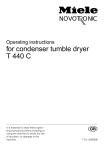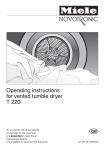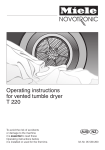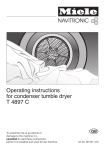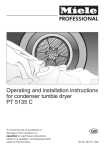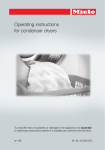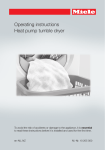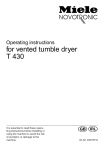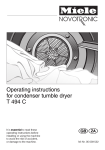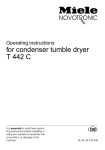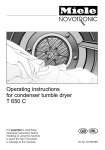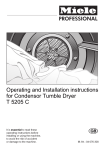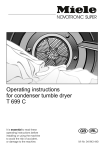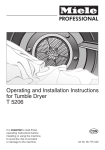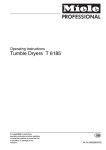Download Miele T 586 C Operating instructions
Transcript
Operating instructions for condenser tumble dryer T 586 C It is essential to read these operating instructions before installing or using the machine to avoid the risk of accident, or damage to the machine. @ä M.-Nr. 04 024 931 Contents Guide to the appliance. . . . . . . . . . . . . . . . . . . . . . . . . . . . . . . . . . . . . . . . . . . . . . . 3 Caring for the environment. . . . . . . . . . . . . . . . . . . . . . . . . . . . . . . . . . . . . . . . . . . . 5 Warning and safety instructions. . . . . . . . . . . . . . . . . . . . . . . . . . . . . . . . . . . . . . 6 For the user Notes on laundry care . . . . . . . . . . . . . . . . . . . . . . . . . . . . . . . . . . . . . . . . . . . . . . . 8 Loading and unloading the machine . . . . . . . . . . . . . . . . . . . . . . . . . . . . . . . . . . . . 9 Programme selection . . . . . . . . . . . . . . . . . . . . . . . . . . . . . . . . . . . . . . . . . . . . . . . 10 Programmable functions . . . . . . . . . . . . . . . . . . . . . . . . . . . . . . . . . . . . . . . . . . . . 13 Programme chart . . . . . . . . . . . . . . . . . . . . . . . . . . . . . . . . . . . . . . . . . . . . . . . 14/15 Maintenance Emptying the condensed water container . . . . . . . . . . . . . . . . . . . . . . . . . . . . . . . Cleaning and care . . . . . . . . . . . . . . . . . . . . . . . . . . . . . . . . . . . . . . . . . . . . . . . . . Problem solving guide . . . . . . . . . . . . . . . . . . . . . . . . . . . . . . . . . . . . . . . . . . . . . . After sales service . . . . . . . . . . . . . . . . . . . . . . . . . . . . . . . . . . . . . . . . . . . . . . . . . 17 18 21 23 For the installer/electrician Installation . . . . . . . . . . . . . . . . . . . . . . . . . . . . . . . . . . . . . . . . . . . . . . . . . . . . . . . 24 Electrical connection . . . . . . . . . . . . . . . . . . . . . . . . . . . . . . . . . . . . . . . . . . . . . . . 27 External drainage of the condensed water . . . . . . . . . . . . . . . . . . . . . . . . . . . . . . 28 Consumption data . . . . . . . . . . . . . . . . . . . . . . . . . . . . . . . . . . . . . . . . . . . . . . . . . 16 Technical Data . . . . . . . . . . . . . . . . . . . . . . . . . . . . . . . . . . . . . . . . . . . . . . . . . . . . 30 2 Guide to the appliance 1 Connection cable (2 m long) 2 Condensed water container 3 Drum door 4 Control panel 5 Drain hose with elbow for condensed water 6 4 Height-adjustable screw feet 3 Guide to the appliance CHECK LIGHT "Empty out container" – The condensed water container must be emptied. ADDITIONAL OPTIONS touch pad selectors: "Temperature low" touch pad selector On/Off button – low temperatures for delicate fabrics, e.g. acrylics. – for switching the appliance on and off. "Buzzer" touch pad selector – The indicator lights in the programme selection touch pads light up. "Door" button – sounds when the drum turns during the intermittent anti-crease action period. "SEQUENCE" indicator lights – opens the door – show the current state of the programme. "COTTONS" touch pad selectors – The drying stage reached is shown. "MINIMUM IRON" touch pad selectors "TIME" display "TIMED DRYING" touch pad selectors – for "time left" and "delay start". "Delay start" touch pad selector – lights up when delay start is selected. "START" touch pad selector – flashes as soon as the dryer is ready to start. – lights up as soon as the programme starts. 4 Guide to the appliance Caring for the environment The drying system Disposal of the packing material The sensitive system automatically adjusts drying to suit the water quality, and makes more exact drying possible. The water conductivity is measured, and registered by the control which then compensates to achieve a uniform residual moisture level. The packaging used to protect the machine during transport largely consists of the following recyclable materials: - Corrugated paper/card - Polystyrene - CFC-free - Polyethylene foil - transparent - Fibreboard (solvent free) - Untreated wood - Packaging straps: Polyamide (blue) Polypropylene (black), Rather than just throwing these materials away please take them to the nearest collection point for specific waste. The Novo Super control offers 9 programmes with electronic moisture measuring and 2 timed programmes. The automatic reversing action turns the drum clockwise and anti-clockwise to loosen the laundry and prevent damp patches and thus ensures even drying results. Energy saving tips Make sure that your laundry is thoroughly spun before drying. You will save up to 35% energy and time if laundry is spun at 1600 rpm instead of at 600 rpm. Disposal of your old appliance Old appliances contain materials which can be recycled. Please contact your local authorities or scrap merchant about potential recycling schemes, before disposing of the appliance. Fold page out to refer to the appliance and its controls. Load according to the optimum amount of washing for the programme to be selected. Underloading is uneconomical. Overloading gives a poorer quality of drying and may cause unnecessary creasing. Before using for the first time Important: The appliance must be properly installed and connected to the electricity supply. 5 Warning and Safety instructions Please read the operating instructions before using the tumble dryer for the first time. They contain important information about the safety, use and maintenance of the machine. This will avoid the risk of accidents and damage to the machine. Keep these operating instructions in a safe place and ensure that new users are familiar with the content. Pass them on to any future owner of the machine. Correct usage The tumble dryer is only intended for drying fabrics, which have been washed in a water solution, marked on the manufacturer’s wash care label as being suitable for tumble drying. Any other applications may be dangerous. The manufacturer is not liable for damage resulting from improper use or operation. Do not let small children play with the machine and its controls or operate it. Please supervise its use by the elderly or infirm. Technical safety Check for visible external damage before installation. Do not install or operate a damaged machine or appliance. Before connecting the machine, ensure that the connection data on the data plate (fusing, voltage and frequency) matches the mains electricity supply. If in any doubt, consult a qualified electrician. 6 The electrical safety of this machine can only be guaranteed when continuity is complete between the appliance and an effective earthing system which complies with local and national regulations. It is most important that this basic safety requirement is regularly tested by a qualified electrician. The manufacturer can not be held responsible for the consequences of an inadequate earthing system. For safety reasons do not use an extension cable. There is a danger of overheating. The machine is built in accordance with current safety requirements. Unauthorised repairs could result in unforeseen dangers for the user, for which the manufacturer can not accept responsibility. Repairs should only be undertaken by a Miele approved engineer. In the event of a fault or for cleaning purposes, the machine is only completely isolated from the electricity supply either when: – the plug is withdrawn, or: – it is switched off at the mains, or – the mains fuse is withdrawn. Faulty components must only be exchanged for Miele original spare parts. Only when these parts are fitted can the safety standards of the machine be guaranteed. The appliance should never be operated without the furniture front panel in place. Warning and Safety instructions Caution: If the appliance is supplied from a cord extension set or electrical portable outlet device the cord extension set or electrical portable outlet device should be positioned so it is not subject to splashing or ingress of moisture. In areas which may be subject to infestation by cockroaches or other vermin, pay particular attention to keeping the appliance and its surroundings in a clean condition at all times. Any damage which might be caused by cockroaches or other vermin will not be covered by the appliance guarantee. Use The appliance is not intended for use by young children or infirm persons without supervision. Young children should be supervised to ensure that they do not play with the appliance. There is a danger of fire with fabrics, which: – contain rubber, foam rubber or rubber-like materials – have been treated with inflammable cleaning agents – have been splashed with hair lacquer, hair spray, nail varnish remover or similar. Do not install the machine in a room where the temperature may drop below freezing. At very cold temperatures the machine may be difficult to start. Laundry will not dry and the "anti-crease" indicator will flash to indicate a problem. Freezing condensed water in the pump, hoses and in the condensed water container can lead to damage. Make sure the drain hose is securely attached if you hang it in a sink or basin (external drainage of condensed water) to avoid the hose slipping and the water causing damage. Condensed water is not drinking water. It can cause health problems in people and animals. Using accessories Accessory parts may only be fitted when expressly approved by Miele. If other parts are used, guarantee, performance and product liability claims may be invalidated. Disposal of your old machine Before discarding an old machine unplug it. Render the plug useless. Cut off the cable directly behind the appliance to prevent misuse. Always close the door after use. This way you will avoid the danger of anyone sitting or leaning on the door, which can cause the machine to tip up. 7 Notes on laundry care Before drying, check the drying symbol on the textile care label Significance of symbols: q = Dry at normal temperature r = Dry at low temperature s = Do not tumble dry. If no symbol is featured dry at your own risk applying the following principles: Cottons and minimum iron items should be dried in the appropriate programme, (see programme charts). For delicate fabrics, e.g. acrylic fibres, the low temperature setting should be selected. (To do this press the "Low temperature" pushbutton). The following fabrics should not be dried in a tumble dryer: – Woollens and wool blends These fabrics tend to become matted and shrink. – Items filled with down The fine fabric interior tends to shrink, depending on the quality involved. – Pure linen These items should only be machine-dried if specified as suitable by the manufacturer on the textile care label, as the surface of the fabric may otherwise tend to "roughen". Note: Some woven and loopknit materials tend to shrink to varying extents depending on their quality. This tendency is exaggerated by over-drying. When purchasing woven materials, it is advisable to take their shrinkage properties into account. Starched washing can also be dried in the tumble dryer. In order to achieve the usual finish, double the amount of starch should be used. Minimum iron items should be spun only briefly before being tumble dried. Such fabrics tend to crease if overdried. These items should be given only a short period in the dryer, and taken out slightly damp. Use the "Minimum iron Normal" programme rather than "Minimum iron Normal+". Minimum iron shirts in 100% cotton may crease during tumble drying depending on the quality and weave. The "Hand iron" setting is recommended for these types of garment. In extreme cases do not tumble dry these garments, but dry them on a hanger. Minimum iron fabrics tend to crease more, the greater the load. This is particularly true of very delicate fabrics. The load should be reduced to1.5 kg or, if necessary, to 1 kg. Dark-coloured garments should be dried separately from light-coloured garments, to avoid colours running. 8 Loading and unloading the machine Load the laundry very loosely into the drum. Duvet covers and pillowcases should be fastened before drying in order to prevent small items from being rolled inside them. At the end of the programme remove the washing from the machine. If this is not done, the machine automatically proceeds into an intermittent anticrease action. The drum rotates at short intervals in order to reduce the possibility of creasing. Once the laundry has been removed, check that the drum is empty. Any items left in the drum could be damaged through overdrying in the next programme. Clean the fluff filters after each drying cycle to prevent excessive energy consumption and longer programme running times. The door should always be closed after. Important: Please check that items of laundry cannot be trapped by the door as this will cause damage to the fabric. 9 Programme selection How the tumble dryer works Time left This tumble dryer is fitted with an electronic sensor system. The required degree of dryness is measured and monitored electronically so that the heating element is switched off as soon as it is reached. The drying cycle automatically finishes with a cool-ling down period. This may be follow- ed by the anti-crease action cycle. The length of the programme in hours and minutes appears and the "time left" indicator light comes on (after the delay start period has expired, if selected) as soon as The following three programme groups are available: - COTTONS six programmes from "Extra dry" to "Machine iron" - MINIMUM IRON three programmes from "Normal +" to "Hand iron" - TIMED DRYING timed drying for up to a maximum of two hours, warm air or cool air. The following additional information is available: SEQUENCE The programme sequence indicator shows the current stage of the programme and the degree of drying reached. Display field "TIME" (h mins) The display field is situated to the right of the sequence indicator and has a double function: – Time left (only for timed drying programme) – Delay start 10 a timed programme is chosen the cooling down phase of the COTTONS or MINIMUM IRON programme is reached. The length of a timed drying programme can be selected using the _ touch pads between 15 minutes and 2 hours. Once the programme has started the time left counts down at 1 minute intervals. Delay start A programme start time can be delayed by a maximum of 9 hours 30 minutes. Select the required programme. Press the DELAY START touch control pad. The indicator light d and the one in the pad light up. Set the delay start by pressing the $ or > touch pads underneath the time display: 1 x press = 30 mins 2 x press = 1 hour Press the START touch pad. The delay start time is displayed and counts down in minutes. Delay start can still be changed after the START pad has been pressed, (provided that the Child Safety option has not been programmed in). Programme selection Once the delay start period has elapsed the programme commences. The control lights "time left" and "delay start" light up, the d indicator light goes out. The following options are now available: either use the programme as displayed by simply pressing the "START" touch pad, or change the programme as required. To delete the delay start function Press the "Delay start" touch pad. The programme commences immediately. Finally press the "START" touch pad. The "START" touch pad The indicator light in the "START" touch pad flashes as soon as the programme is ready to be started. Press the "START" touch pad. The programme commences. Selecting a programme The programme can only be selected when the drum door is properly shut and the machine is switched on. Press the On-Off button, the indicator lights for the basic programmes light up. Select the required programme The indicator lights for the other programmes go out. The indicator lights for the additional options selected light up. Once a programme has been selected, the indicator lights for the additional option(s) set the last time the dryer was used, automatically illuminate, (the so-called memory function). For timed drying the most recently selected time appears in the display. Selecting additional features For "temperature low" and "buzzer" there are the following choices: Use the additional options set for the previous drying cycle, or change the additional option(s) by pressing the relevant touch pad(s). The indicator lights will either light up for confirmation or go out. Where an additional option has been chosen, it can be cancelled by pressing once again on the relevant touch pad. Correct procedure for drying: Load the drum Close the door with a firm swing. Do not push it shut. Switch on the machine Select a programme by pressing the appropriate touch pad Select additional option(s) if required Select "Delay start" if required Press "START" touch pad 11 Programme selection Opening the door during a programme To change a programme where the "Child safety" feature is activated: The door can be opened during a programme to add items for drying, or to remove items early. To continue the programme: This is not possible after the "START" touch pad has been pressed to start the programme. Close the door Press "START" (N.B. The programme will not continue if it has already reached the "anticrease" stage.) If you wish to make a change: Switch the machine off and then on again. Select the correct programme, and Delay start if required. After drying: To change or select a different programme during drying: (This is only possible if the "Child safety" feature has first been cancelled) Press the required programme selector touch pad. A change is only possible within the programme group already chosen, (e.g. Cottons to Cottons, but NOT Cottons to Timed drying, or Timed drying to Minimum Iron). It is too late to change a programme once the "cooling down" phase has been reached. If you have chosen a programme in the wrong group: Switch the machine off and then on again. Select the correct programme, and Delay start if required. To change the length of time in a "Timed drying" programme or for Delay start: Press the > or $ touch pad. 12 Remove the laundry Switch off the machine using the "OnOff" button. Clean the fluff filter. Empty the condensed water container. To cancel or delete a programme: Switch off the machine using the "OnOff" button. What to do in a power cut The programme stage reached or the delay start time is stored in the machine’s memory. As soon as the power is restored the programme continues. If the power cut is longer than 30 minutes, the "START" touch pad must be pressed to continue the programme. The programme will not continue if it has already reached the "anti-crease" stage. Programmable functions Two additional functions can be programmed if required: Child safety feature for programme selection (P 1 ) This feature is pre-programmed exworks as standard. After the "START" touch pad has been pressed it is not possible to change the programme. The only way to change the programme is to switch off and start again. Altering the degree of drying (P 2 ) If you would prefer your washing to be drier at the end of a programme, you have the facility to reduce the degree of residual moisture slightly in the fabrics for all programmes. It is not possible to alter just one programme. This is not pre-programmed ex-works. To select programming mode: The machine must first be switched off and the door closed. Under the "Minimum iron" field press and hold in the "Normal +" and "Hand iron" touch pads, while at the same time switching on the machine with the On/Off button. "P " appears in the Time display. To call up and store the required programmable function(s): Press the > touch pad under the Time display once for P 1 or twice for P 2 . To move from P 2 to P 1 press the $ touch pad. In the left of the display field "P " and the number of the selected function appear alternately. In the right of the display field there appears "0 " if the function is not programmed, "1 " if the function is programmed in. If you need to change from one to the other press the "START" touch pad. After the required function has been selected and programmed: Switch off the machine using the "OnOff" button. The programmable function(s) is/are stored. To cancel a programmable function: Call up the programmable function in question. Press the "START" touch pad to deselect, i.e. to bring up "O ". Switch off the machine using the "OnOff" button. The individual function(s) can now be selected and programmed in. 13 Programme chart COTTONS Fabric type Maximum load Special notes Extra dry Multi-layered fabrics, not thoroughly dried with "Normal + " 5 kg Do not dry jerseywear in the Extra dry programme - tendency to shrink Normal + Mixed load of cotton fabrics, eg towelling, jerseywear, ie single and light multi-layered fabrics 5 kg – Load of similar cotton fabrics (jerseywear, flannelette sheets, towelling) 5 kg If fabrics are too damp, select "Normal +". Cotton or linen fabrics (eg table linen, bedlinen, starched laundry etc) 5 kg – 5 kg If fabrics are too damp for hand ironing, select Hand iron r Cotton or linen fabrics, including starched laundry, for machine ironing 5 kg The laundry should be rolled up to prevent it from drying out until it can be ironed Normal (*) Hand iron r Hand iron rr (*) Machine iron (*) Note for Test Institutes: These are the programmes to be tested according to the EN 61121/A11 Standard. 14 Programme chart MINIMUM IRON Fabric type Maximum load Special notes Normal + Minimum iron items made of synthetics or blended fabrics, eg pullovers, dresses, trousers etc, which are not dried adequately in the "Normal" programme. 2.5 kg Spin minimum iron fabrics for approx. 30 seconds in the washing machine before drying. Normal (*) Minimum iron shirts, table cloths etc made of blended fabrics, eg cotton/synthetics 2.5 kg Hand iron Minimum iron shirts, table cloths etc made of blended fabrics, eg cotton/synthetics, which are still to be hand ironed 2.5 kg With blended fabrics consisting of wool and synthetics, consult the manufacturer’s instructions, as the wool component may cause the fabric to become matted and shrink. (*) Note for Test Institute: This is the programme to be tested according to the EN 61121/A11 Standard. TIMED DRYING Fabric type Maximum load Special notes Warm Individual items, eg bathing trunks / costumes – – Cool air Items which are only to be aired. 5 kg – 15 Consumption data Drying stage capacity Final spin speed in a domestic washing machine Electricity consumption (kg) (rpm) (kWh) Drying time incl. cooling down time (mins) Extra dry 5 1200 1400 1550 3.44 3.28 3.17 87 83 81 Normal+ 5 1200 1400 1550 3.17 3.02 2.91 81 77 75 Normal (*) 5 800 (70% res. moisture) 3.68 92 Normal 5 1200 1400 1550 2.88 2.74 2.64 74 71 69 Hand iron rr (*) 5 800 (70% res. moisture) 2.86 74 Hand iron rr 5 1200 1400 1550 2.10 1.96 1.86 56 53 51 Machine iron 5 1200 1400 1550 1.65 1.51 1.41 47 43 41 Normal+ 2.5 1000 1.68 50 Normal (*) 2.5 1000 (50% residual moisture) 1.41 45 Hand iron 2.5 1000 1.21 37 COTTONS MINIMUM IRON All values obtained in accordance with standard test EN 61121/A11. (*) Test programme according to EN 61121/A11. Different types of fabric, the load and residual moisture after spinning may affect the figures given. 16 Emptying the condensed water container The dryer does not need to be connected to a venting system or to be plumbed in. The moisture extracted during tumbling is condensed and collected in the condensed water container, situated at the left of the facia panel. It holds approx. 4 litres of water and should be emptied after each drying cycle. To empty the condensed water container Slide the cap of the drainage outlet in the direction of the arrow and hold to the side while emptying. After emptying, release the cap which will automatically close over the drainage outlet. Push the container fully in until it engages into place. If the container is still full when a new programme is started or during a programme: the indicator light "empty out container" will come on. a buzzer sounds the drying programme is interrupted the washing is cooled and the indicator "Cooling down" lights up Note: Pull the container out of the machine Because of the distilling action during drying, the water from the condensed water container is pure enough to be used in a steam iron or humidifier. Laundry must be thoroughly rinsed if the condensed water is to be used. To be completely sure that no particles of fluff are carried into the appliance where they could cause damage, pass the condensed water through a fine sieve or paper filter. 17 Cleaning and care The fluff which occurs during drying is collected in the fluff filters in the door and in the door opening. Remove the small filters in the door opening and rinse them well under running hot water. Clean the filters after every programme to save time and energy. Dry the filters before putting them back in place. Grip the filter by the recessed handle and pull upwards to clean. Remove any remaining fluff from the hollow part of the door through the wide slit at the bottom. 18 Before cleaning the tumble dryer: Always disconnect the machine from the power supply. The dryer can be cleaned with a cloth using soapy water or a mild detergent (not scouring powder) and dried with a soft cloth. The drum and other stainless steel parts of the casing may be cleaned using a suitable proprietary stainless steel cleaner following the manufacturer’s instructions and dried with a soft cloth. The machine must never be hosed down. Do not use any abrasive substances or scouring pads to clean the machine. Cleaning and care Condenser unit This should be cleaned once or twice a year. Turn the levers on the condenser unit to the vertical position The machine must be disconnected from the electricity supply before cleaning. Open the door Turn the cover lock to the vertical position Pull out the condenser unit Pull the cover off 19 Cleaning and care Clean the condenser unit at both ends (front and back), and along the two long sides Stand the condenser unit lengthwise on a towel until it is quite dry Replace the condenser unit in the reverse order 20 Put the cover back on and lock in place. Finally pull on the cover to test that it and the condenser unit are firmly in place, otherwise water may leak from the machine. Problem solving guide Electrical appliances should only be repaired by qualified personnel. Incorrectly repaired machines may pose a considerable risk to the user. There are, however, minor faults which can be corrected without contacting the Service Department. If the indicator lights do not light up, check that the "On-Off" button is pressed in the door is properly closed the mains plug is plugged in and the fuse or circuit breaker has not tripped. Laundry is not sufficiently dry. The load consists of dissimilar items in terms of size and fabric. Select a longer drying programme next time. Activate the programmable function "Altering the degree of drying". Small loads or individual items may cause the programme to terminate prematurely. The air inlet below the drum door may be blocked, preventing fresh air from being drawn in. Ventilation is inadequate (e.g. in a small room). When the machine is in operation, open a door or the window. Water comes out of the machine just after the condenser unit has been cleaned. Check that the condenser unit has been correctly replaced, and secure it if necessary. Items made of synthetic fibres are charged with static electricity after drying. Static charge can be reduced by adding fabric conditioner during the final rinse cycle in the washing machine, or a fabric conditioner sheet in the tumble dryer. Build up of fluff Fluff comes off textiles naturally during wearing and washing. The fluff that collects in the filters of a tumble dryer has no effect on the lifetime of your laundry. Small loads should therefore be "time-dried". Drying times are too long. Clean the fluff filters in the door and in the door opening. The laundry was not spun for a sufficiently long time. 21 Problem solving guide To open the door in the event of power failure The drum door opens during the drying cycle. The machine has overheated. The temperature limiter opens the drum door and thus causes the machine to switch off automatically. Possible reasons for overheating: The fluff filters in the door and in the door opening are clogged up. The condenser unit is blocked. Before restarting the programme, proceed as follows: Release the On-Off button Clean the affected part of the machine Water droplets appear at the upper edge of the drum aperture A double filter system with dual insulation prevents fluff from being deposited in the condenser unit. This means that the condenser unit does not need to be cleaned so often. The dual insulation can lead to the build-up of condensate. Laundry being removed from the machine may come into contact with these water droplets. They will, however, dry off in a matter of minutes. Switch the machine on again Press the "Start" touch pad Should the drum door open again, this must be due to a technical fault and the Service Dept. should be contacted. Three horizontal lines appear in the Time display "---". This may be because the machine has been on for too long, and a safety cutout has operated. Start the programme again. If the lines appear again, this indicates a fault. Call the Miele Service Dept. 22 Problem solving guide The interior drum lighting fails to function. The bulb may be defective. Replace it as follows: Open the door. Switch off the machine or disconnect from the mains supply. Use a 19 mm spanner to unscrew the plastic cover inside the drum above the door (see illustration). After-sales service In the event of any faults which cannot be remedied, or if the appliance is under guarantee, please contact: – your Miele Dealer or – the nearest Miele Service Department (see back cover for the address). When contacting the Service Department, please quote the Model and Serial nos. of your appliance, both of which are shown on the data plate on the right hand side below the opening to the drum. Example: The light bulb must not exceed the maximum wattage quoted on the data plate and the plastic light cover. Replace the bulb and the plastic cover. The cover must be fixed securely, as otherwise moisture may seep in and cause a short-circuit. The temperature-resistant bulb should only be ordered from your Miele Dealer or the Service Dept. 23 Installation The machine must be perfectly level to ensure safe and proper operation. Minor differences do not, however, have an adverse effect on operation. Important The ventilation slots beneath the door must not be blocked by deep pile carpet, plinths etc., as this will prevent a sufficient intake of cold air. Building under It is possible to install this appliance under a continuous worktop in a kitchen run: A special building under kit * is required. The machine lid must be replaced by a cover plate. This must be fitted by a suitably competent person exactly according to the fitting instructions to ensure electrical safety. The screw feet can be adjusted to compensate for any uneveness in the floor surface. Fitting instructions are included with the kit. For installation under a work surface 900/910mm from the floor, a spacer kit * is required. Connection to electricity should be made in such a way that it remains accessible when the machine is in place. * These items are all available from your Miele Dealer, or the Miele Domestic Sales Dept. 24 Installation Washer-Dryer stack This tumble dryer can be stacked on a Miele washing machine. A stacking kit* can be purchased from the Miele Domestic Sales Department. All parts marked * are available from the Miele Spare Parts or Sales Department. Fitting or changing the decor panel Note: The door should be shut for fitting or changing the decor panel. Remove the 4 screws from the decor strip on the door catch side of the door and remove the decor strip. Unscrew the remaining 7 screws from the lower and side decor strip until the decor panel bows slightly and can then be taken out or put in place. Re-assemble in the reverse order and tighten the screws. Decor panel dimensions (The figures given in brackets indicate the tolerance level in mm.) Width: Height: Thickness: 587 (-1) mm 602 (-1.5) mm 1 (+ 0.5) mm Panels more than 1.5 mm thick require an "adapter strip for a 4 mm thick decor panel". This is available from your Miele Dealer or the Miele Spare Parts Department. Note: The decor panel height required for the adapter strip must not exceed 596.5 (-1.5) mm. 25 Installation Fitting a plinth facia The appliance plinth below the door can be concealed using a plinth facia. The height and return of the appliance plinth cannot be altered. A higher plinth facia can only be installed if the overall niche height is higher. Plinth height 100 mm (standard) Niche height 820 mm: Plinth height 150 mm Niche height 870 mm: a spacer frame is required. Plinth height 200 mm Niche height 920 mm: two spacer frames are required. A plinth facia (60 cm long) can be ordered from your kitchen Dealer or manufacturer. For Miele kitchens please quote the model number when ordering. A cut-out must be made in the plinth facia around the ventilation slots as otherwise the airflow to the appliance will be blocked and the machine will not work. 26 Fitting the plinth facia Stick the small template (supplied) to the rear upper edge of the plinth facia. Cut the plinth facia out following the template. Use the strip supplied to seal the cutout edge. Stick the velcro fastener provided to the appliance plinth. For this the following procedure is recommended: Match up the hooked side and the looped side of the velcro fastener lengthwise. Cut into 2 or 3 pieces. Peel off the protective backing from one of the velcro fastener pieces. Position the cut pieces along the appliance plinth, at the left and right hand edge, and in the middle. Press firmly into place. Now peel the protective backing off the other velcro fastener piece. Address the plinth facia to the adhesive backing on the velcro and press firmly into place. Electrical connection This tumble dryer is supplied ready for connection to an a.c. single phase supply. The machine is supplied with a 2 m long mains cable with moulded plug. Important The appliance should be connected up only by a qualified electrician, in accordance with national and local safety regulations. Green/yellow = earth Blue = neutral Brown = live For extra safety it is advisable to install a residual current device (RCD) with trip current of 30 mA. The voltage, rated load and fuse rating are given on the data plate. Please ensure that these match the household mains supply. The wires in this mains lead are coloured in accordance with the following code: As the colours of the wires in the mains lead of this appliance may not correspond with the coloured markings identifying the terminals in your plug, proceed as follows: The wire which is coloured green and yellow must be connected to the terminal in the plug which is marked with the letter E or by the earth symbol z or coloured green or green and yellow. The wire which is coloured blue must be connected to the terminal which is marked with the letter N or coloured black. The wire which is coloured brown must be connected to the terminal which is marked with the letter A or coloured red. WARNING THIS APPLIANCE MUST BE EARTHED 27 External condensed water outlet The condensed water can be drained off directly if the machine is installed near a sink, drain outlet, etc. Accessories supplied: Push the drain hose onto the drain outlet. Make sure that the hose is firmly secured by the clip and not kinked. - 2 m drain hose - Hose clamp - Rubber connection sleeve - Hose clip Installation: Detach the hose clip from the drain outlet at the back of the machine and remove the rubber plug. Max. drain hose length: 3.0 m Max. delivery head: 1.0 m 28 External condensed water outlet The machine is fitted with a non-return valve as standard to prevent water from flowing back into the machine (eg. if the machine is connected to a siphon). Close the water inlet port above the condensed water container with the bottom part of the rubber plug. The plug must face towards the interior of the machine so that the condensed water container can easily be inserted. Connection to wash basin drain outlet Push the hose clip (1) and knurled nut connector (2) (from the sink drain outlet) over the drain hose. Put the adapter sleeve (3) supplied into the hose. Screw the drain hose to the drain outlet with the knurled nut connector. Tighten the hose clip (1) up close to the nut (2). 29 Technical data Height. . . . . . . . . . . . . . . . . . . . . . . . . . 85.0 cm (adjustable +1/-0.5 cm) Width . . . . . . . . . . . . . . . . . . . . . . . . . . 59.5 cm Depth (incl. distance from wall) . . . . . . 60.0 cm Weight . . . . . . . . . . . . . . . . . . . . . . . . . 57 kg Drum volume . . . . . . . . . . . . . . . . . . . . 103 l Capacity . . . . . . . . . . . . . . . . . . . . . . . . 5 kg dry weight Voltage . . . . . . . . . . . . . . . . . . . . . . . . . 230 V - 240 V, 50 Hz Rated load . . . . . . . . . . . . . . . . . . . . . . 2200 W - 2400 W Plug rating . . . . . . . . . . . . . . . . . . . . . . 10 A Max. delivery head. . . . . . . . . . . . . . . . 1.0 m Max. drain hose length. . . . . . . . . . . . . 3.0 m Test certificates . . . . . . . . . . . . . . . . . . Electrical Safety Radio/ TV suppression Electrically suppressed acc. to . . . . . . AS/NZS 1044:1995 30 Alteration rights reserved/000 This paper is made from 100% chlorine free material and is recyclable. 3897
































